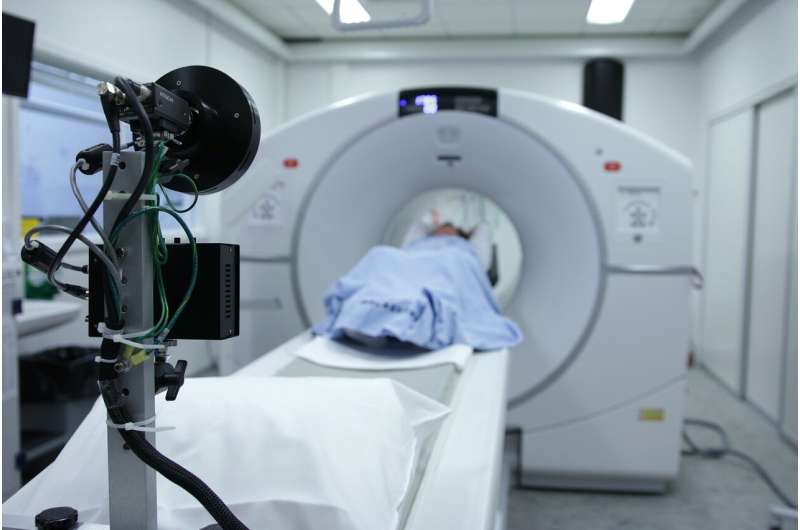Producing F-18 radiopharmaceuticals for PET imaging

Recently ANSTO researchers have made progress investigating improved ways to make life-saving radiopharmaceuticals using the fluorine-18 radioisotope so they can be available in more hospitals at lower cost.
The fluorine-18 [18F] radioisotope is essential for hundreds of thousands of PET scans annually around the world. It is most often used in the form of [18F]FDG for diagnosing cancer but is also important for diagnosing brain disorders including Alzheimer's disease.
This development came about following research by Monash University Ph.D. candidate Bo Zhang and collaborators at ANSTO, who focussed on synthesising [18F]ethenesulfonyl fluoride (ESF) - a new reagent for easily radiolabelling biological molecules under mild conditions.
"Bo successfully made the new reagent with an efficient method under mild laboratory conditions, using a specialised precursor developed in-house at ANSTO" said Dr. Ben Fraser, (pictured below) who with colleague Dr. Giancarlo Pascali supervised Zhang. Prof Andrea Robinson, an expert in peptide and protein synthesis, supervised Zhang's studies at Monash University.
"No research group has previously labelled this molecule, which involved attaching the [18F]fluorine to a sulphur atom bound to a bio-reactive moiety," said Pascali (pictured below), who oversaw the radiolabelling reactions using a microfluidic approach at the National Research Cyclotron.
By using microfluidic reactors, the investigators to optimise reactions in a few days that otherwise would take months. Pascali is a world expert in using the technique.
Zhang used [18F]ESF to attach fluorine-18 to several amino acids and two 'proof of concept' proteins in various solvents using a short "ageing" process at room temperature.
"This showed how straight-forward the method is for adding fluorine-18 to molecules so they can be quickly evaluated as new radiopharmaceuticals," said Fraser.
The research, a world- first use of [18F]ESF was published in the Journal of Labelled Compounds and Radiopharmaceuticals in June 2018.
"However, the final [18F] labelled amino acids and proteins degraded when tested for stability in serum, therefore making them unsuitable for use in PET imaging. Luckily, sometimes in science and particularly chemistry, when things do not go as expected, it opens up other possibilities," said Fraser.
"As we suspected the new reagent was losing free fluoride, we saw another possible use," said Pascali.
"The tendency for these labelled amino acids and even ESF to drop their fluoride label meant we might be able to use them to transfer radioactive fluoride onto other important radiopharmaceuticals, such as FDG or Fallypride."
"Since [18F]ESF can be easily trapped on small cartridges, this gave us the idea that it can represent a source of shippable, ready-to-use 18F source," explained Pascali.
This idea was tested in the final year of Zhang's Ph.D. work and proved successful for the radiolabelling of many model and real-life PET tracers.
"Given the broad impact of this work, we were gratified that our paper was recently published in the prestigious journal Chemistry—A European Journal," said Pascali.
"We have now verified that [18F]ESF containing cartridges can be used to successfully perform radiolabelling reactions in minimally equipped facilities. This discovery could widen up the access and availability of less common 18F radiopharmaceuticals to hospitals that predominantly use technetium-99m based SPECT radiopharmaceuticals."
"We are starting to have discussions with potential partners about developing this technology, and are encouraged local clinical interest. Our new approach is being viewed as a way to differentiate and personalise radio-diagnostics," said Pascali.
More information: Bo Zhang et al. [18F]Ethenesulfonyl Fluoride as a Practical Radiofluoride Relay Reagent, Chemistry – A European Journal (2019). DOI: 10.1002/chem.201900930
Bo Zhang et al. Synthesis, bioconjugation and stability studies of [18F]ethenesulfonyl fluoride, Journal of Labelled Compounds and Radiopharmaceuticals (2018). DOI: 10.1002/jlcr.3667
Journal information: Chemistry – A European Journal




















